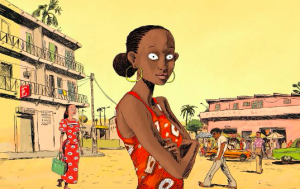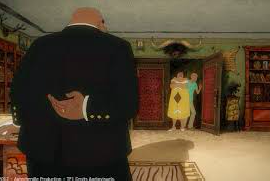Gender Roles in Aya
Gender Roles in Aya~
Gender roles are present in different cultures and determine how males and females should act and think. Throughout the graphic novel, ‘Aya’ by Marguerite Abouet, the representation of men and women differs through their actions, interactions, and social expectations.
Females are represented in a wide variety of different ways throughout the graphic novel, which provides a wider spectrum of understanding of culture and prevents the creation of stereotypes against a specific gender. For example, the roles for females, which are consistent across many societies, is the idea that they must stay at home to care for their children and husband. However, one of the main characters, Aya, does not follow (or wish to follow) this belief. She can be seen telling her father that she wishes to be a doctor, and says “I don’t want to end up in the “C” series,” which is described as ‘combs, clothes, and chasing men’. On the other hand, the characters Adjoua and Bintou are quite open and enjoy spending their time partying- therefore not following the conservative ideals of the gender roles. This explains that despite the gender roles existing, many do not follow them, which shows a modernization in society and cultures. This can be further be supported by the pregnancy that Adjoua went through with, despite this proving that she was not pure or innocent. The fact that the father of the baby was thought to be Moussa, who was known for being rich, also created conflict between Bintou and Adjoua, as they were both fighting for the s
doctor, and says “I don’t want to end up in the “C” series,” which is described as ‘combs, clothes, and chasing men’. On the other hand, the characters Adjoua and Bintou are quite open and enjoy spending their time partying- therefore not following the conservative ideals of the gender roles. This explains that despite the gender roles existing, many do not follow them, which shows a modernization in society and cultures. This can be further be supported by the pregnancy that Adjoua went through with, despite this proving that she was not pure or innocent. The fact that the father of the baby was thought to be Moussa, who was known for being rich, also created conflict between Bintou and Adjoua, as they were both fighting for the s ame man, and were interested in how well off they would be in life if they got married.
ame man, and were interested in how well off they would be in life if they got married.
On the other hand, the representation of males throughout the graphic novel is not one which can be described as positive. There are no male figures that are not represented in a negative light. For example, Moussa is represented as overly jealous, such as when Bintou was talking to another man and he believed that he owned her. He is often seen taking advantage of his wealth to lure women towards him and does not realize that his actions can have negative consequences as he is blinded by his wealth. Aya’s father is also shown as being unfaithful, which can be seen when he left the house to go on a business trip and stops his car along the road to talk to the girls he thought were pretty. Similarly, Adjoua’s father is not involved in the lives of his children, and rather, constantly drinks.

Through the comparative position between men and women in Post-colonial Ivory Coast, I believe that Abouet is trying to explain the fact that women, despite being oppressed by gender roles, continue to have open minds and want to live out their lives to the fullest, while men focus on themselves and wish to express their wants and desires without thinking of the consequences.










 n from his mother’s family they were eventually allowed to marry.
n from his mother’s family they were eventually allowed to marry.
